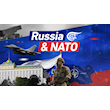NATO allies to boost high readiness forces to 'well over 300,000'
NATO chief Jens Stoltenberg reveals the increase in "high readiness" forces to 300,000 in light of the "transformative" summit next week.
-

Forces would be pre-assigned to defend specific NATO members on the alliance's vulnerable eastern flank
NATO allies will increase high readiness forces to "well over 300,000" troops in response to Russia's military operation in Ukraine, alliance chief Jens Stoltenberg said Monday.
Leaders of the US-led military alliance will meet in Madrid this week for a "transformative" summit, according to Stoltenberg, as the alliance deals with the fallout from Moscow's operation in its pro-Western neighbor.
Allies will beef up some of their battle group deployments along NATO's eastern flank "up to brigade level" – tactical units of several thousand troops – and increase high readiness numbers to "well over 300,000," according to Stoltenberg.
Read next: NATO begins military drills near Russian border
Additionally, more heavy weaponry, including air defense systems, would be deployed, and forces would be pre-assigned to defend specific NATO members on the alliance's vulnerable eastern flank.
"This constitutes the biggest overhaul of our collective defense and deterrence since the Cold War," Stoltenberg said.
Stoltenberg did not elaborate on the additional high-readiness forces or how they might be deployed by the alliance. NATO currently commands a force of approximately 40,000 troops in high readiness.
The over 300,000 troops are expected to form a larger pool from which the alliance could draw in the event of an emergency.
While the #West failed #Ukraine on the battleground, it still sent a colossal amount of weapons and intelligence tools to the Nazi regime in its war with #Russia. pic.twitter.com/5GsPOgfV7O
— Al Mayadeen English (@MayadeenEnglish) June 9, 2022
Stoltenberg also stated that leaders would agree to increase NATO's vital aid to beleaguered Ukraine, whose President Volodymyr Zelensky is scheduled to call in via video link.
This package would include "substantial deliveries" of equipment such as secure communications, anti-drone systems, and fuel, as well as long-term assistance in transitioning Ukraine to more advanced NATO-standard arms.
This package would include "substantial deliveries" of equipment such as secure communications, anti-drone systems, and fuel, and would help Ukraine transition to more advanced NATO-standard arms in the long run.
Read next: Ukraine got only 10% of pledged weapons: Deputy Defense Minister

 2 Min Read
2 Min Read









